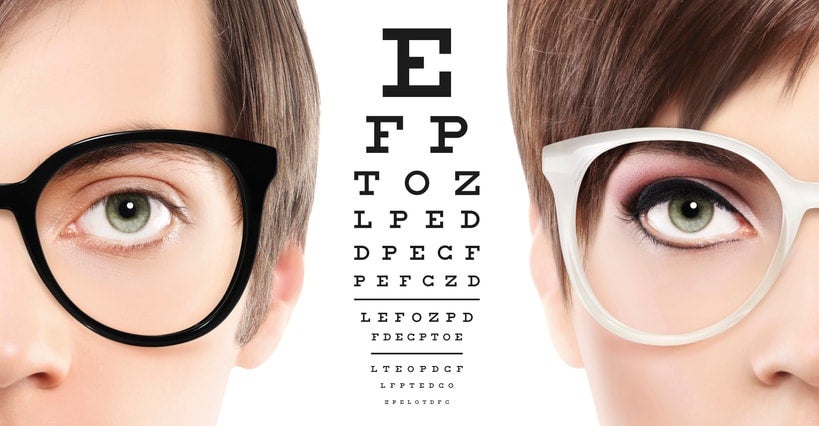-
How to Read your Eye Prescription and What it Means

You’ve visited the eye doctor and obtained a prescription for eyeglasses or contacts, but when you look at your prescription, all you see is letters and numbers. For the uninitiated, an eye prescription can be confusing. It’s actually not too complicated, once you know what those letters and numbers mean.
The numbers on your prescription will be listed under headings listed as OS and OD. Those headings are Latin abbreviations: OS means oculus sinister, which refers to the left eye, and OD means oculus dexterous, the right eye. Some prescriptions will also have the abbreviation OU, which stands for oculus uterque and pertains to both eyes. You might also see the letter D, which stands for diopters, the unit doctors use to measure
You’ll also notice that in front of the numbers that follow there are plus or minus signs. A plus sign (+) indicates farsightedness, while a minus sign (-) means that you’re nearsighted. How nearsighted or farsighted you are is indicated by the numbers: as a rule, the further away the number is from zero, the worse your vision and the higher your requirement for vision correction.
For instance, a prescription that says -1.00 indicates one diopter of nearsightedness, which is a fairly mild level of nearsightedness. Someone with a higher level of nearsightedness, perhaps -4.25, would require a much stronger corrective lens, which would be thicker. Farsightedness works the same way, with a +5.00 prescription being much stronger than, for instance, a +1.00.
Are there more letters and numbers on your prescription? If you have astigmatism, there should be three sets. They will generally be written as S x C x Axis. S means spherical, and it will be the number discussed earlier, describing farsightedness or nearsightedness. C is for cylinder, which is referring to the astigmatism. This can be a negative or positive number, showing in diopters your degree of astigmatism. The larger the number, the more severe the astigmatism. The number for the Axis is expressed in degrees and will be somewhere between 0 and 180. Astigmatism is a curvature of the cornea, and the Axis is the number that indicates that curvature’s orientation.
If your prescription says ADD, that abbreviation is referring to the magnifying power for your reading, progressive or bifocal lenses. The same number will apply to both eyes. If you see the abbreviation PD, that stands for Pupillary Distance, the distance between the centers of your two pupils.
On a contact lens prescription, you’ll find the same listing of power under OD and OS, and some of the same information you’d see on an eyeglasses prescription. In addition, however, a contact lens prescription will include the prescribed brand, as well as numbers following the abbreviations BC and Dia. BC means Base Curve, Dia stands for diameter, and these two measurements together ensure the proper fit on your eye’s surface.
If you are looking for an eye doctor, the Gerstein Eye Institute in Chicago can help. Since 1968, the Gerstein Eye Institute has been providing exceptional ophthalmologic care to patients in the Chicago area. With decades of experience in ophthalmology, our certified professional staff members work hard to provide the kind of personalized care that keeps patients coming back year after year, eventually entrusting the eye health of their children and grandchildren to us as well. To schedule an appointment, call us at (773) 973-3223 or contact us through our website.
-
How to Heal your Eyes Overnight

Ah, bedtime! Sleep is one of the most restorative things we can do for our bodies, and as we rest overnight, we’re giving our bodies the chance to burn calories, renew our minds, and even heal from injuries. How does getting a full night of sleep affect our eyes? Additionally, what can we do to help promote eye health while we’re sleeping? Here, we offer tips on how to heal your eyes overnight.
- Getting the right amount of sleep can help prevent several eye issues. Those who do not get a full night of sleep each night are at risk of conditions like ischemic optic neuropathy, eye spasms, eye strain, and dry eye. The quality of your sleep matters, too. Sleep apnea, a condition that causes sporadic interruptions in breathing that disrupt your sleep, has been linked to the development of glaucoma. The National Sleep Foundation recommends that adults get somewhere between six and ten hours of sleep each night, and studies have shown that getting at least five hours of sleep each night is vital for eye health.
- Go to bed with a clean face. Gently remove any eye makeup, using eye makeup remover or a cotton pad with olive oil or another pure oil. Steer clear of anything with heavy fragrance or essential oils, to avoid irritating the sensitive skin around your eyes. Use patting motions and light, gentle, swipes, avoiding any rubbing or pulling at this tender area. Be similarly careful in the selection and application of any eye cream or nightly moisturizer.
- What you do during the day matters, too. Eat a balanced diet, full of nutrient-dense foods like greens, fish, and sweet potatoes, and consider taking a daily vitamin to promote eye health. If you must spend a great deal of time working at a computer, follow the 20-20-20 rule to prevent eye strain. Look away from the computer for 20 seconds, every 20 minutes, focusing on something 20 feet away.
- If your eyes seem puffy or tired, try a home remedy. Resting your eyes for a few minutes under cucumber slices, cooled chamomile tea bags, or even cold spoons. You may also find it helpful to find an eye cream with antioxidants, vitamins, and moisturizers.
- See an eye doctor regularly. While sleeping and eating well can provide your body with the resources it needs to heal your eyes overnight, regular visits to the eye doctor are important for finding and treating eye problems. Many eye diseases have no symptoms in their beginning stages, yet are most easily remedied when they’re discovered early.
If you are looking for an eye doctor, the Gerstein Eye Institute in Chicago can help. Since 1968, the Gerstein Eye Institute has been providing exceptional ophthalmologic care to patients in the Chicago area. With decades of experience in ophthalmology, our certified professional staff members work hard to provide the kind of personalized care that keeps patients coming back year after year, eventually entrusting the eye health of their children and grandchildren to us as well. To schedule an appointment, call us at (773) 973-3223 or contact us through our website.
